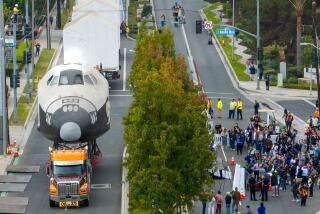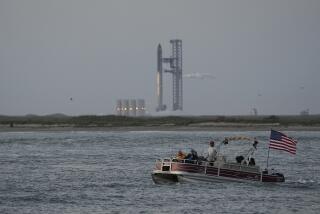NASA takes its ‘flying saucer’ for a test spin
On Tuesday afternoon, just about lunch time, a “flying saucer” was undergoing a spin test in a clean room at NASA’s Jet Propulsion Laboratory.
The saucer is technically a 15-foot wide, 7,000-pound aerodynamic test vehicle. It is designed to help engineers try out new technologies for landing spacecraft, and someday people, on Mars.
The vehicle does bear a passing resemblance to a flying saucer, but if you are hungry, it also looks like a giant pie.
Journalists who had been invited to watch the spin test at the lab in La Cañada Flintridge were asked to duck behind a bulletproof shield once it got going, but it is not clear that was entirely necessary.
The test was similar to the type a mechanic might run to make sure the wheels of your car are balanced. The saucer never spun faster than 30 revolutions per minute, and it didn’t seem like anything might fly off it.
“What we are trying to do here is to make sure the center of the mass is as close to where the spin motor will go as possible,” said Paul Lytal, an engineer working on the project.
In a few weeks the saucer will be shipped to Hawaii, where it will be lifted to an altitude of 160,000 feet via a balloon about the size of the Rose Bowl. Then a rocket will take it 20,000 feet higher to the thin air of the stratosphere.
The atmosphere on Mars is 1% as dense as Earth’s, but it is similar in density to our stratosphere. By deploying new decelerating technologies at these heights, the engineers hope to see how they might work in a Martian-like environment.
“The thing about Mars is it has just enough atmosphere to help you out, and just enough to give you trouble,” said Kevin Burke, flight systems manager for what is known as the Low-Density Supersonic Decelerator project, or LDSD.
Since 1976, when NASA’s Viking probe first landed on the Red Planet, the agency has relied on the same parachute design to help all its Mars landers and rovers descend to the surface intact.
So far, it has worked fabulously, but if NASA wants to land bigger spacecraft on Mars -- and eventually people -- the landing system will need to change.
Last year the LDSD team took an identical test vehicle to Hawaii to try out two new decelerating technologies. One was an enormous parachute, 100 feet in diameter. The other was essentially a large, quick inflating inner tube that can increase the diameter of the vehicle from 15 feet to 20 feet in a fraction of a second, creating more drag without adding much more weight.
During the Hawaii test, the inner tube, also known as the Supersonic Inflatable Aerodynamic Decelerator, worked perfectly, but the parachute shredded to bits almost immediately.
“It was fascinating to watch,” said Jeff Weiss, LDSD deputy project manager. “And since then we’ve looked at the footage frame by frame to see where it failed and where it didn’t, and learn from those lessons.”
The LDSD team has since completely redesigned the parachute, and the researchers said they hoped it would perform better than its predecessor.
“We are hopeful, but until we test it, we really don’t know,” said Weiss.
Science rules! Follow me @DeborahNetburn and “like” Los Angeles Times Science & Health on Facebook.







